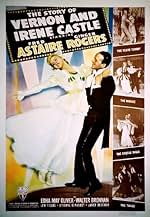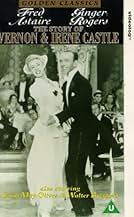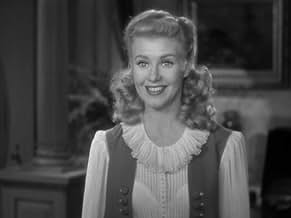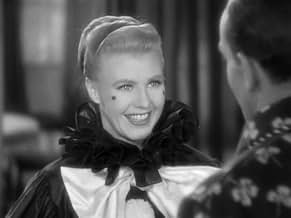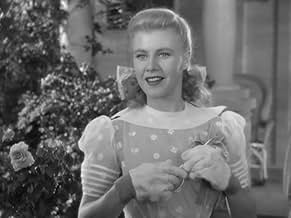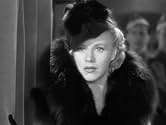IMDb RATING
6.9/10
2.9K
YOUR RATING
The story of the dancing team who taught the world to two-step.The story of the dancing team who taught the world to two-step.The story of the dancing team who taught the world to two-step.
- Awards
- 4 wins & 1 nomination total
Buzz Barton
- Undetermined Secondary Role
- (uncredited)
Max Barwyn
- Waiter - Cafe de Paris
- (uncredited)
Featured reviews
This bio-pic about the hugely successful dance team, Vernon and Irene Castle, starts at the time of their meeting and covers the entire breadth of their career, starting just before the advent of WWI. This film was released in 1939, so film audiences had plenty of choices and the competition was strong. Still, this ninth pairing of Fred Astaire and Ginger Rogers experienced modest success.
Irene Castle herself was a technical adviser and helped design the gowns that Ginger wore--which, by the way, are very nice, despite Ginger's protestations.
Because this film covers many years and many happenings, it uses montage quite heavily--something that is usually distracting, but in this case it works well.
The dancing documents a variety of styles, some of which were introduced by Vernon and Irene. At the height of their career, they were trendsetters in dance, fashion, culture and taste. Their first dance in the film is an adaptation of minstrel dancing; later dances include the tango and foxtrot. Astaire must have been familiar with all of these styles and probably had used them in his choreography with sister Adele. Still, his choreography in the film is inspired--showing us the essence of each stage in dance evolution.
Ginger is beautiful and she seems to have a freedom in her performance, as if their relationship had advanced to the point of total trust. I only wish this film--and a few of their others--had been shot in color.
Irene Castle herself was a technical adviser and helped design the gowns that Ginger wore--which, by the way, are very nice, despite Ginger's protestations.
Because this film covers many years and many happenings, it uses montage quite heavily--something that is usually distracting, but in this case it works well.
The dancing documents a variety of styles, some of which were introduced by Vernon and Irene. At the height of their career, they were trendsetters in dance, fashion, culture and taste. Their first dance in the film is an adaptation of minstrel dancing; later dances include the tango and foxtrot. Astaire must have been familiar with all of these styles and probably had used them in his choreography with sister Adele. Still, his choreography in the film is inspired--showing us the essence of each stage in dance evolution.
Ginger is beautiful and she seems to have a freedom in her performance, as if their relationship had advanced to the point of total trust. I only wish this film--and a few of their others--had been shot in color.
The great irony here is that today, if the professional dancing team of Vernon and Irene Castle is remembered at all, it is because Fred Astaire and Ginger Rogers played them in a movie. Plus,many people don't like "The Story of Vernon and Irene Castle", and just find it lacking something. This is probably because there is virtually no romantic conflict between the two in this film. Astaire & Rogers spend practically the entire film either allied or happily married. Because the two are happily married in the film, you're missing all of the fun of the misunderstandings, squabbling, and sexual tension of their other RKO starring vehicles. The conflict is first economic and professional as the pair struggled to get recognized as great dancers, and then there is World War I in which Vernon Castle, as an English native, feels compelled to enlist. The film is quite good, but it is very sentimental and atypical of Astaire & Rogers' other films. This was intended to be the pair's last film together, and was their last film together at RKO. It was just a series of accidental recasting decisions that led them to reunite in "The Barkleys of Broadway" at MGM ten years later, which was a big splash musical in the big splashy MGM tradition, quite different from their earlier films together.
"The Story of Vernon and Irene Castle" was the last of the major Fred Astaire - Ginger Rogers musicals of the 1930s. And it was different in many ways from the others, namely that the story was more important than the songs and dances.
Really, is "Top Hat" with its emphasis on production numbers linked by a thin plot of mistaken identity really a lot different than today's action movies with endless car chases and pyrotechnic special effects linked by a very thin story about a hit man or the earth getting hit by a comet? Sorry about that analogy, I'll take the great musicals over the "actions" any day! "Yo" is not great dialog.
My parents tell me that at the time, this film was panned by the critics and did not make it as big at the box office. Could it be that everyone wanted another "Top Hat" or Swing Time?" I enjoyed those lovely musicals with their big production numbers. Could it be the emphasis on Vernon's patriotic service with the RAF in World War I might have offended many people's "isolationism" in 1939 about the growing World War II?
Fred and Ginger wanted to do a movie with more substance, and they pulled it off in grand style. The songs and dances were nice, with only one very brief "production number." But they did a great job of showing how two young entertainers met, fell in love, became famous, and made a sacrifice in the war. In 1911, young Irene Castle "discovers" Vernon, a second-rate vaudeville comic when she sees him dancing at an evening outing. She shows Vernon her not ready for prime time dance number "The Yama Yama Men." The two fall in love and marry, and with a lot of self-taught dance technique, suddenly hit the big time in France by dancing their famous "Castle Walk." The Castles' fame grew and grew and they toured Europe and America, and made a lot of money through merchandising things like Irene Castle hats. Long before Michael Jordan's basketball shoes. In fact, you will see entries for both Vernon and Irene here in the Movie Database. Irene went on to star in a few silent films, but never made a "talkie." You'll be glad to know that Irene served as an advisor for the Rogers -Astaire film, enhancing its accuracy.
As always, they had some great character actors. I never knew Walter Brennan was ever that young. Fred and Ginger really showed a depth to their acting. From there, of course, Ginger moved into dramatic movies, including her Oscar-winning "Kitty Foyle." I think Fred's later movies matured too.
In short, I think you will like this movie, but don't expect to see a clone of "Swing Time."
Really, is "Top Hat" with its emphasis on production numbers linked by a thin plot of mistaken identity really a lot different than today's action movies with endless car chases and pyrotechnic special effects linked by a very thin story about a hit man or the earth getting hit by a comet? Sorry about that analogy, I'll take the great musicals over the "actions" any day! "Yo" is not great dialog.
My parents tell me that at the time, this film was panned by the critics and did not make it as big at the box office. Could it be that everyone wanted another "Top Hat" or Swing Time?" I enjoyed those lovely musicals with their big production numbers. Could it be the emphasis on Vernon's patriotic service with the RAF in World War I might have offended many people's "isolationism" in 1939 about the growing World War II?
Fred and Ginger wanted to do a movie with more substance, and they pulled it off in grand style. The songs and dances were nice, with only one very brief "production number." But they did a great job of showing how two young entertainers met, fell in love, became famous, and made a sacrifice in the war. In 1911, young Irene Castle "discovers" Vernon, a second-rate vaudeville comic when she sees him dancing at an evening outing. She shows Vernon her not ready for prime time dance number "The Yama Yama Men." The two fall in love and marry, and with a lot of self-taught dance technique, suddenly hit the big time in France by dancing their famous "Castle Walk." The Castles' fame grew and grew and they toured Europe and America, and made a lot of money through merchandising things like Irene Castle hats. Long before Michael Jordan's basketball shoes. In fact, you will see entries for both Vernon and Irene here in the Movie Database. Irene went on to star in a few silent films, but never made a "talkie." You'll be glad to know that Irene served as an advisor for the Rogers -Astaire film, enhancing its accuracy.
As always, they had some great character actors. I never knew Walter Brennan was ever that young. Fred and Ginger really showed a depth to their acting. From there, of course, Ginger moved into dramatic movies, including her Oscar-winning "Kitty Foyle." I think Fred's later movies matured too.
In short, I think you will like this movie, but don't expect to see a clone of "Swing Time."
Here's one of those rare films that I like where there are no villains, just a nice, old-fashioned story with good people.
Of all the Fred Astaire-Ginger Rogers films, I would guess this gets the least amount of publicity and if that's true, it's a shame.
There are plenty of dance scenes in here. I prefer the tap dancing to ballroom, but that's just my personal tastes. The famous dancing duo are great with any style. I like Walter Brennan, so it's nice to see him in this film and it also was nice to see Edna May Oliver play a nice character, for a change.
The only complaint was the ending was so predictable. You see it coming a mile away. How true this story is, I can't say, but overall it's one of my favorite Astaire-Rogers movies. I am sorry it gets so little attention.
Of all the Fred Astaire-Ginger Rogers films, I would guess this gets the least amount of publicity and if that's true, it's a shame.
There are plenty of dance scenes in here. I prefer the tap dancing to ballroom, but that's just my personal tastes. The famous dancing duo are great with any style. I like Walter Brennan, so it's nice to see him in this film and it also was nice to see Edna May Oliver play a nice character, for a change.
The only complaint was the ending was so predictable. You see it coming a mile away. How true this story is, I can't say, but overall it's one of my favorite Astaire-Rogers movies. I am sorry it gets so little attention.
The Story of Vernon and Irene Castle is the last of the 9 RKO musicals Astaire did with Rogers. However, from a story point-of-view, it is their best film by a mile. The contest isn't even close, IMO.
It's not their best musical. This film is really a drama with a few musical interludes, whereas most of the other Astaire-Rogers films were musical comedies. Those other films had flimsy plots at best and were saved only by their songs and dances. BUT - "Vernon and Irene" could easily stands alone without any songs or dances. It even has some action sequences as is typical of war-time films (WWI, in this case).
The film is a bio-pic about the Castles, who in their heyday were even bigger than Astaire and Rogers. The choreography is more attuned to 1910's sensibilities than the usual Astaire and Rogers film, but that's okay. Astaire and Rogers dance just well as always.
As the dancing duo's last RKO film, V&C is quite classy and a fine close to a great RKO dancing career for the two.
It's not their best musical. This film is really a drama with a few musical interludes, whereas most of the other Astaire-Rogers films were musical comedies. Those other films had flimsy plots at best and were saved only by their songs and dances. BUT - "Vernon and Irene" could easily stands alone without any songs or dances. It even has some action sequences as is typical of war-time films (WWI, in this case).
The film is a bio-pic about the Castles, who in their heyday were even bigger than Astaire and Rogers. The choreography is more attuned to 1910's sensibilities than the usual Astaire and Rogers film, but that's okay. Astaire and Rogers dance just well as always.
As the dancing duo's last RKO film, V&C is quite classy and a fine close to a great RKO dancing career for the two.
Storyline
Did you know
- TriviaIrene Castle served as a technical advisor on the film. According to Ginger Rogers, Castle disliked every costume she wore and deemed them anachronistic. Due to censorship restrictions, Rogers' costumes evoked late 1930s fashions rather than the more daring styles of Castle's 1910s era. After Rogers refused to bob her hair to portray the hairstyle that Irene had popularized, Castle became more displeased. The studio silenced Castle's protests with an additional payment of $5,000.
- GoofsThe film erroneously depicts the Castles touring with white orchestras. In actuality, Vernon and Irene Castle always toured with a black orchestra; specifically, James Reese Europe's Society Orchestra.
- Quotes
Irene Castle: I thought you could be a first dancer, a very beautiful first dancer because you are a beautiful dancer but you're so smug and conceited that you can't see any further than your funny nose!
- ConnectionsFeatured in Fred Astaire: Puttin' on His Top Hat (1980)
- SoundtracksOnly When You're in My Arms
(1939)
by Con Conrad - Herman Ruby Bert Kalmar
Sung by Fred Astaire (uncredited)
End dance: Fred Astaire (uncredited) and Ginger Rogers (uncredited)
- How long is The Story of Vernon and Irene Castle?Powered by Alexa
Details
Box office
- Budget
- $1,196,000 (estimated)
- Runtime1 hour 33 minutes
- Color
- Aspect ratio
- 1.37 : 1
Contribute to this page
Suggest an edit or add missing content

Top Gap
By what name was The Story of Vernon and Irene Castle (1939) officially released in Canada in English?
Answer
